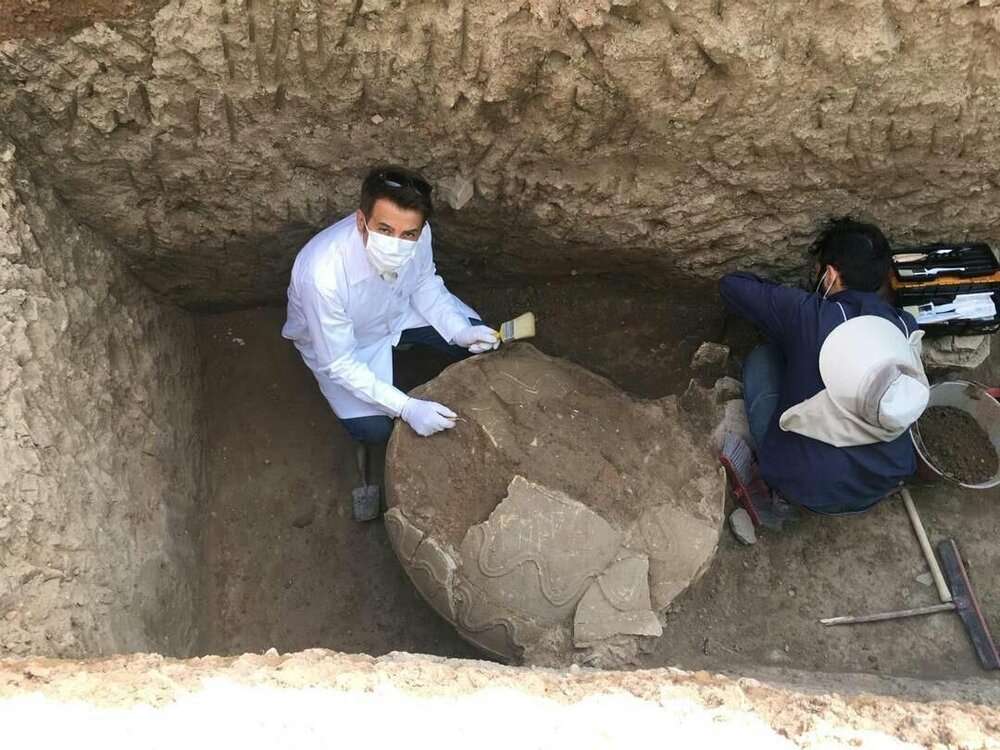Discovery of bizarre tomb offers clues to ancient life in Iran
Discovering the second giant jar grave on the historic Isfahan Hill has shed new light on ancient human life in the central Iranian city.

“Finding the second giant jar-tomb on the historical hill of Isfahan – ‘ Tepe Ashraf ‘ or ‘ Tappeh Ashraf ‘ – confirms a previous hypothesis of a Parthian period cemetery in the eastern part of the hill. Now, Tepe Ashraf is the second place after the Tepe Sialk (in Isfahan province) that has yielded the discovery of such jar tombs that offers valuable clues to uncover the obscure history of pre-Islamic Isfahan,” IRNA quoted senior archaeologist Alireza Jafari-Zand as saying on Friday.
Jafari-Zand, who heads the archaeological excavation at the hill, believes that the cemetery could be covering a large area, adding “When we discovered the first jar-shaped tomb, we assumed that we should reach other ones until yesterday (on June 20) we could discover another one of these tombs embedded in a giant earthen jar.”
The archaeologist is confident that further excavations will lead to the unearthing of other examples of this type of burial places, the report said.
“The discovery of the second jar-shaped burial place in the eastern part of Tepe Ashraf proves to the archaeological hill we may have encountered a Parthian cemetery.”
Over the past couple of days, the team has uncovered ancient stone well estimating to date back to the time of Sassanids.
Some clay works from Seljuk and Buyid dynasties have also been found while workers were digging the ground for water piping of the six-meter well.
Researchers say the square stone well is historically very valuable in terms of its physical shape and form. The well is dug among the rocks and is six meters deep.
“Excavations on Tepe Ashraf began in 2010 and lasted for six seasons. Now, with the operation to save the historical works of the two hills of Jey and Ashraf, important objects were found that could help us in the excavations of the seventh season.”
Jafari-Zand further noted that the pottery found in the projects is amazingly undamaged and they can help a lot to say the exact age of the ancient site of Ashraf and Jey. The artifacts found in this area belong mostly to pre-Islamic periods up to the 5th century AH, he reiterated.
According to this archaeologist, the only place where archaeological excavations have been carried out in Isfahan in the past was the Atigh Grand Mosque, where only two or three pieces from the Sassanid era had been identified, and the rest were from the Islamic period.
Back in 2010, Jafari-Zand announced that his team had found evidence at the site suggesting that the Sassanid site had also been used during the Buyid dynasty (945–1055). “We stumbled upon a reconstructed part in the ruins of the castle, which suggests that the structure had been used during the Buyid dynasty.”
“The bricks used in the rebuilt part are very similar to bricks used in the construction of the Shahrestan Bridge and the Isfahan Congregational Mosque, which date to the Buyid era,” he added.
The archaeologists believe that their excavations at the mound, which is located in the urban area of the city, will be helpful in the development of archaeological studies in the ancient city.
“Isfahan is a city, which has never died over the history… and the old Isfahan is beneath the modern city. Thus, normally, archaeological excavation is impossible in the city,” according to Jafari-Zand who believes that the mount keeps a part of the history of Isfahan and Iran in its heart.
The mound has seriously been damaged on the northern side by the construction of a street. Besides, unscientific excavations carried out by several archaeology interns in 1987 disturbed the historical strata in a part of the site.
Soaked in a rich history, Isfahan was once a crossroads of international trade and diplomacy in Iran during the 16th and 17th centuries, and now it is one of Iran’s top tourist destinations for good reasons. Isfahan is filled with architectural wonders such as unmatched Islamic buildings, bazaars, museums, Persian gardens, and tree-lined boulevards. It’s a city for walking, getting lost in its mazing bazaars, dozing in beautiful gardens, and meeting people.
It has long been nicknamed as Nesf-e-Jahan which is translated into “half the world”; meaning seeing it is relevant to see the whole world.





